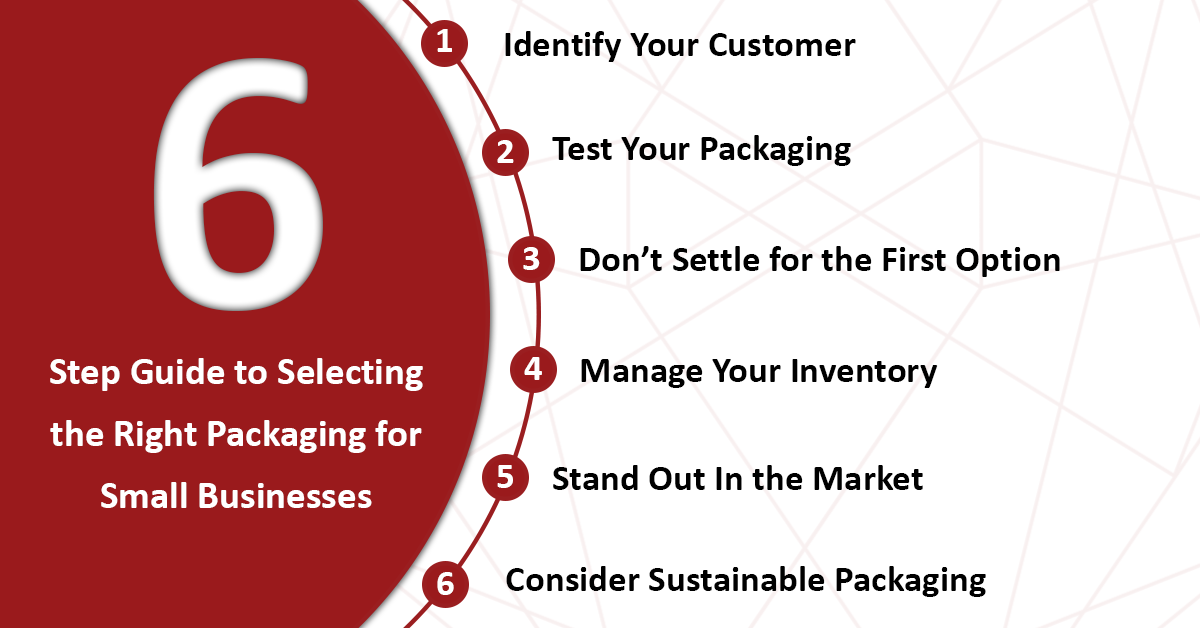Here’s How to Avoid Selecting Just Any Type of Packaging
You’ve researched how to start, run, and grow your business; you’ve spent an infinite amount of time laying down the groundwork and yet it feels as if you’re overlooking something, but what could it be? If you haven’t done your packaging research, then it might be time to put aside the belief that any old packaging will get the job done. Selecting generic packaging that doesn’t meet your products’ needs, provide sufficient security, or appeal to your client base could hinder your ability to succeed and no one wants that. Everyone’s needs for packaging are different, which is why a one-size-fits-all solution won’t work here, so here are our top six-factors for narrowing down the right packaging for you.

-
Identify Your Customer
- You could have an amazing product, but if you can’t communicate that to the right set of individuals, then your launch is going to fall flat at the hands of uninterested customers. You have mere seconds to capture the attention of individuals online or in stores, so knowing who to target, where to find them, and what they’re interested in could make the difference in your success. Some other factors that you should also conduct research on are your customer’s pain points and buying habits. Knowing your customer’s preferences and problems can help you narrow down packaging that will not only appeal to their needs, but also assists them in overcoming their obstacles.
-
Test Your Packaging
- There’s much more to the packaging process than what meets the eye and the entirety of the process can be quite extensive, so finding an option that not only appeals to your customers, but can handle the journey is a must. Your packaging needs to be able to withstand the distribution and delivery process so it’s essential to make sure that your package’s strength and structural integrity don’t falter. The last thing you want your customers to receive is a damaged product; not only does it cost you to replace it, but it’s also costing you your brand’s loyalty; when customers feel like they can’t rely on you, they’re less likely to purchase from you again or talk positively about you to others.
-
- What kinds of tests should your packaging be able to pass? According to Rocket Industrial, it’s important that your packaging option pass distribution tests, drop impact, compression, and material tests. The road from your production facility or home base to your customer’s hands can be quite bumpy and once again the goal should always be for your product to arrive at its final destination in top conditions.
-
Don’t Settle for the First Option
- Let’s say that you pick the first packaging option that you come across, what are the odds that it’ll meet your expectations as well as your customers? It’s important to narrow down which packaging options will reduce or eliminate the chances of your goods being damaged. If anything, start researching packaging dimensions, materials, quantities, read reviews, request samples, testing, etc., exhaust every option possible before you decide on one. Remember, the priority is to create a positive experience for the customer from start to finish. Supposing that the customer has had a positive experience with your brand up until they receive your package, then the interaction will end on a sour note, which will ultimately result in the customer remembering your brand in a negative light.
-
Manage Your Inventory
- Splurging isn’t typically an element that’s found within a small-business or start-up company’s budget, so finding areas where it’s possible to save is an absolute must. However, the path to savings may not always be a straight shot; normally, when companies order large quantities of packaging they receive reductions in their total costs as opposed to ordering smaller quantities. While the best option might seem to order in bulk, you’ll have to ask yourself if you’ll have the necessary space to store it all. If you don’t have the space to store your bulk order of packaging, then you can find third-party vendor managed inventory programs that allow you to reduce crowding by monitoring, sourcing, and replenishing your supplies. If you manage to find a trustworthy vendor managed inventory program, then it could lead to cost effective benefits.
-
Stand Out In the Market
- It can be intimidating to enter a market where the average customer’s attention span is only a mere 10-20 seconds; however, that’s not to say that standing out in a saturated market is impossible. As a start-up or small-business, it’s important to take advantage of every opportunity you have to bring awareness to your brand. According to Packaging Supply, “an attractive, sturdy, and user-friendly package can go a long way and help transition your start-up into an established and profitable brand."
-
- Not only does your packaging help you stand out in the industry, but it can help you make that first impression; use that space as a way to convey your brand’s logo, message or motto, aesthetic, etc. Putting some thought into your packaging can help customers recognize your brand and product; in addition, customers enjoy showing off their new products and the “cool” packaging it comes in. Ending up on your customers’ social media platforms will not only bring you exposure, but potential customers are more likely to trust someone they follow or have as a friend than your brand, at least in the beginning.
-
Consider Sustainable Packaging
- Nowadays the push toward sustainability can be seen throughout a variety of industries, so much so that consumers now consider it a factor in their purchasing journey. According to some research conducted by Statista, 45% of consumers are interested in sustainable or environmentally responsible brands and 44% of consumers are interested in brands that support recycling. Having a positive environmental impact is an aspect of packaging that should not be overlooked.
-
- Making an effort to include sustainable packaging can help your company reduce its carbon footprint, which in turn helps to protect the environment. In addition, it also helps to reduce the impact on area landfills, which again helps to boost your brand’s image and highlights your environmental responsibility.
With so many packaging factors to take into account it’s easy to feel overwhelmed; the best thing to do is take your time to do some research and narrow down your priorities. You don’t have to follow each one of these tips, or any at all, but it would be best to pick a few that resonate with your brand and mission. Once you’ve decided on the type of packaging that would work best for your process, the journey doesn’t end there; in order to make sure that your product can be stocked on store shelves, those lot codes, batch codes, date codes, and other bits of traceability information need to be present on your packages and product. “Great, yet another task that’s being added onto your plate;” contrary to popular belief, beginning your coding and marking process doesn’t have to be expensive or complicated.
Typically, start-ups and small-businesses are looking for simple-affordable systems that are easy to integrate, operate, and maintain; with SNEED-JET ® thermal-inkjet coders adding traceability information and personalized messages can be done in a matter of seconds. Whether you’re looking for an inline or handheld printing solution our Sneed experts can help you select the thermal-inkjet coding solution that’s best fit for your process. While we’re known for #KeepingCodingSimple, we’ve recently added #KeepingPackagingSimple to our mission as well. It might be some time before your production volumes begin to surpass your manual packaging processes, but that’s no reason to not plan ahead; our SNEED-PACK case sealers and box erectors are here to help you save time, money, material, and labor.



